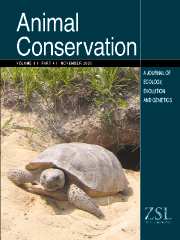Crossref Citations
This article has been cited by the following publications. This list is generated based on data provided by
Crossref.
Pudyatmoko, Satyawan
., Djuwantoko
and
., Yusuf Sabarno
2007.
Evidence of Banteng (Bos javanicus) Decline in Baluran National Park, Indonesia.
Journal of Biological Sciences,
Vol. 7,
Issue. 6,
p.
854.
Andersen, Reidar
Karlsen, Jørn
Austmo, Lars Bendik
Odden, John
Linnell, John D. C.
and
Gaillard, Jean-Michel
2007.
Selectivity of eurasian lynx Lynx lynx and recreational hunters for age, sex and body condition in roe deer Capreolus capreolus.
Wildlife Biology,
Vol. 13,
Issue. 4,
p.
467.
Smit, Izak P.J.
Grant, Cornelia C.
and
Devereux, Bernard J.
2007.
Do artificial waterholes influence the way herbivores use the landscape? Herbivore distribution patterns around rivers and artificial surface water sources in a large African savanna park.
Biological Conservation,
Vol. 136,
Issue. 1,
p.
85.
Månsson, Lena
Ripa, Jörgen
and
Lundberg, Per
2007.
Time series modelling and trophic interactions: rainfall, vegetation and ungulate dynamics.
Population Ecology,
Vol. 49,
Issue. 4,
p.
287.
Garrott, Robert A.
White, P.J.
Becker, Matthew S.
and
Gower, Claire N.
2008.
The Ecology of Large Mammals in Central Yellowstone - Sixteen Years of Integrated Field Studies.
Vol. 3,
Issue. ,
p.
519.
Codron, D.
Codron, J.
Lee-Thorp, J.A.
Sponheimer, M.
Grant, C.C.
and
Brink, J.S.
2009.
Stable isotope evidence for nutritional stress, competition, and loss of functional habitat as factors limiting recovery of rare antelope in southern Africa.
Journal of Arid Environments,
Vol. 73,
Issue. 4-5,
p.
449.
DRUCE, DAVE J.
BROWN, JOEL S.
KERLEY, GRAHAM I. H.
KOTLER, BURT P.
MACKEY, ROBIN L.
and
SLOTOW, ROB
2009.
Spatial and temporal scaling in habitat utilization by klipspringers (Oreotragus oreotragus) determined using giving‐up densities.
Austral Ecology,
Vol. 34,
Issue. 5,
p.
577.
Smit, I.P.J.
and
Grant, C.C.
2009.
Managing surface-water in a large semi-arid savanna park: Effects on grazer distribution patterns.
Journal for Nature Conservation,
Vol. 17,
Issue. 2,
p.
61.
Chown, Steven L.
2010.
Temporal biodiversity change in transformed landscapes: a southern African perspective.
Philosophical Transactions of the Royal Society B: Biological Sciences,
Vol. 365,
Issue. 1558,
p.
3729.
Owen‐Smith, N.
Chirima, G. J.
Macandza, V.
Le Roux, E.
and
Gordon, Iain
2012.
Shrinking sable antelope numbers in Kruger National Park: what is suppressing population recovery?.
Animal Conservation,
Vol. 15,
Issue. 2,
p.
195.
Beale, Colin M.
Rensberg, Sue van
Bond, William J.
Coughenour, Mike
Fynn, Richard
Gaylard, Angela
Grant, Rina
Harris, Brian
Jones, Trevor
Mduma, Simon
Owen-Smith, Norman
and
Sinclair, Anthony R.E.
2013.
Ten lessons for the conservation of African savannah ecosystems.
Biological Conservation,
Vol. 167,
Issue. ,
p.
224.
Capon, Simon D.
Leslie, Alison J.
and
Clegg, Bruce
2013.
The use of population viability analysis to identify possible factors contributing to the decline of a rare ungulate population in south-eastern Zimbabwe.
Koedoe,
Vol. 55,
Issue. 1,
Kimanzi, Johnstone K.
Sanderson, Roy A.
and
Rushton, Stephen P.
2014.
Habitat suitability modelling and implications for management of roan antelopes in Kenya.
African Journal of Ecology,
Vol. 52,
Issue. 1,
p.
111.
Heinsohn, Robert
Webb, Matthew
Lacy, Robert
Terauds, Aleks
Alderman, Rachael
and
Stojanovic, Dejan
2015.
A severe predator-induced population decline predicted for endangered, migratory swift parrots ( Lathamus discolor ).
Biological Conservation,
Vol. 186,
Issue. ,
p.
75.
Havemann, Carl P.
Retief, Tarryn A.
Tosh, Cheryl A.
and
de Bruyn, P. J. Nico
2016.
Roan antelope Hippotragus equinus in Africa: a review of abundance, threats and ecology.
Mammal Review,
Vol. 46,
Issue. 2,
p.
144.
Everatt, Kristoffer T
Andresen, Leah
Ripple, William J
and
Kerley, Graham IH
2016.
Rhino poaching may cause atypical trophic cascades.
Frontiers in Ecology and the Environment,
Vol. 14,
Issue. 2,
p.
65.
Ali, Abdullahi H.
Ford, Adam T.
Evans, Jeffrey S.
Mallon, David P.
Hayes, Matthew M.
King, Juliet
Amin, Rajan
Goheen, Jacob R.
and
Hayward, Matt
2017.
Resource selection and landscape change reveal mechanisms suppressing population recovery for the world's most endangered antelope.
Journal of Applied Ecology,
Vol. 54,
Issue. 6,
p.
1720.
Kimanzi, Johnstone K.
2018.
Population Viability Analysis of the Endangered Roan Antelope in Ruma National Park, Kenya, and Implications for Management.
The Scientific World Journal,
Vol. 2018,
Issue. ,
p.
1.
Hauck, Markus
Leuschner, Christoph
and
Homeier, Jürgen
2019.
Klimawandel und Vegetation - Eine globale Übersicht.
p.
287.
G., Ibiso
G.,C., Akani
A., Nioking
and
C. O., Glorious
2021.
Population Abundance of Antelopes Based on Prevalence in Some Selected Markets in Rivers State, Nigeria.
African Journal of Environment and Natural Science Research,
Vol. 4,
Issue. 3,
p.
45.


